
When Hassan Black moved to Greensboro, North Carolina, a year or so ago, he often rode the bus. And he often spent a lot of time waiting for the bus, because he never quite knew when the next one was arriving.
His frustration could have ended there, but it didn’t. Through a friend, he heard about a process called participatory budgeting, which Greensboro’s city government was using for the first time this year. It allowed city residents, rather than elected representatives, to directly decide how to spend a portion of city funds.
The result: The Greensboro Transit Authority is installing software that will allow passengers to track bus movements and better plan their days. “I was really happy,” said Black, who this year is starting a master’s program in information technology at North Carolina A&T State University. “I put a lot of time and effort into that, and now I’ll be able to see the results. It’s important for anybody who rides the bus.”
Participatory budgeting, or PB for short, is the idea that putting some of the power of the purse directly in the hands of citizens can pay powerful dividends. It makes sure that the city funds things residents really want, strengthens democracy, and builds trust between elected officials and the people they represent. A growing number of cities around the world — including Sevilla in Spain, Belo Horizonte in Brazil, and Newcastle in the United Kingdom — use PB for slices of their budget.
The handful of communities that use it in the United States tend to be major cities and often leave the decision of whether to deploy it up to individual council members. The result is that one part of the city might have PB; another won’t.
That’s why what’s happened in Greensboro is so important. It’s a mid-sized southern city of about 285,000 people, and it’s also doing the process citywide, across all five of its districts. Greensboro has a progressive streak — it’s where the sit-ins to end racial segregation began in 1960 at a Woolworth’s lunch counter — but no one’s going to mistake it for a liberal enclave. In other words, according to PB’s supporters, if the process can work here, it can work anywhere.
Here’s how PB operates in Greensboro. The city council agreed to allocate $100,000 for expenditures in each district through participatory budgeting. The additional cost of implementation, approximately $200,000, was split between the city and local advocates, who received much of their funding from community foundations. The implementation costs include the expense of evaluating suggestions and for hiring the Participatory Budget Project, the New York nonprofit that is leading the PB movement in the United States, to oversee the engagement process.
PB is just a drop in the bucket of Greenboro’s budget of about $488 million — it amounts to spending about one-tenth of one percent of the city’s total budget through the public process. But the results still mean a great deal for residents who will benefit from the projects across the city.
In years past, Greensboro’s budget would simply have been presented at a public hearing. While residents who attended those meetings could make recommendations, the truth is that by the time a budget was formally proposed it was difficult to change. As Council Member Nancy Hoffman said: “At a typical budget meeting, you come and then we tell you what were are going to do.”
PB helps city officials find out what people want done, she said, but the information flows both ways. Citizens also come away with a greater understanding of how government works and what projects actually cost. Hassan Black, for example, said he worked closely with the city’s transit authority, and the process helped him better appreciate government and also realize the importance of direct communication. “It teaches you how to have good people skills,” he said.
 Ranata Reeder, Greensboro’s participatory budgeting community engagement coordinator. (Photo: Ken Otterbourg.)
Ranata Reeder, Greensboro’s participatory budgeting community engagement coordinator. (Photo: Ken Otterbourg.)
Ranata Reeder, the community engagement coordinator for Greensboro’s PB process, said that the initial round of submissions produced 675 suggestions. Many of those couldn’t be considered for further review. Some were too vague. Others were for projects that were too grand or would require operating as well as capital expenses. “You say you want a lazy river,” she said, referring to an actual submission. “You’re not going to get a lazy river.”
Eventually, about 90 proposals were sent to the city staff for cost estimates. Some of those were dropped as too expensive, but the ones that survived moved on to expos around the city.
The expos — held at community centers and libraries — looked like a science fair for adults. There were cardboard displays on folding tables, each filled with pictures and graphics and brightly colored lettering. One woman kept a glue stick close at hand. The sessions offered a chance for residents to learn more about the proposals and for their proponents to lobby for support during the actual voting, which took place over two weeks in April.
Many of the recommended projects were for simple improvements that make a neighborhood more livable or safer. Residents proposed crosswalks for intersections, chess tables at parks, a sun canopy at a public pool, and a big mural on a downtown parking garage. Reeder said the proposals reflect the needs of residents, particularly in poorer parts of Greensboro, where small improvements — such as a bench to sit on while waiting for the bus — can make a big difference.
 Greensboro resident Kathy Newsom with her project proposal. (Photo: Ken Otterbourg)
Greensboro resident Kathy Newsom with her project proposal. (Photo: Ken Otterbourg)
“For many people in low-wealth neighborhoods, these projects are the bare minimum of what they need,” she said. It’s not that the conventional budget process sets out to ignore these residents. But by inverting the process, PB helps ensure that more voices are heard.
Spoma Jovanovic, a professor at the University of North Carolina at Greensboro, was one of the people who helped bring PB to the city. It took four years of lobbying and advocacy that began in 2011. At first, the ordinariness of the proposals left her a little disappointed, but she realized that the submissions reflected the needs of city residents. “It gives city officials a level of comfort,” she said, because they aren’t being asked to fund superfluous projects. “It fosters trust both ways.”
Voting on the projects occurred in late April. Fliers announcing the balloting were printed in five languages, including Arabic and Vietnamese, a testament to Greensboro’s growing immigrant population. The winning projects included that downtown mural and sun canopy, as well as bus shelters and emergency call boxes at several parks. Because the bus system is citywide, Black’s bus app proposal had to win approval in all five districts. The cost of that project is $90,000, nearly a fifth of the total.
Kevin Williams, the co-chairman of the city’s PB steering committee, said he was encouraged by the involvement of people who are ordinarily shut out of the political process. “We’re reaching out to homeless and immigrant communities,” he said.
Williams is a former chairman of the city’s human relations commission, and he said that participatory budgeting has the potential to bridge gaps between communities that too often talk past each other.
“Historically, this city has been — how would you say it? — we’re liberal but we’re conservative,” he said. “There are certain ideas that are appealing but to get the oomph to go after it is a different story.” Participatory budgeting gives him encouragement that the city can keep becoming more inclusive.
David Beasley, the communications director with the Participatory Budgeting Project, said that roughly 20 communities in the United States and Canada are using or have used PB in some form. He said that for the movement to grow, cities have to use PB consistently, not just in one-time, feel-good events. And over time, he would like to see more cities use participatory budgeting for operating budgets, not just capital expenses or one-time programs. That’s only occurred in a handful of cities.
But before that happens, PB needs to be standard operating procedure, not an occasional exercise in democracy. In Greensboro, the news is encouraging. The process is tentatively included in the budget for next year. That means another round of community discussion over projects, more votes that put residents in charge of a slice of spending, and — yes — more poster board presentations and glue sticks.
Join us in defending the truth before it’s too late
The future of independent journalism is uncertain, and the consequences of losing it are too grave to ignore. To ensure Truthout remains safe, strong, and free, we need to raise $46,000 in the next 7 days. Every dollar raised goes directly toward the costs of producing news you can trust.
Please give what you can — because by supporting us with a tax-deductible donation, you’re not just preserving a source of news, you’re helping to safeguard what’s left of our democracy.